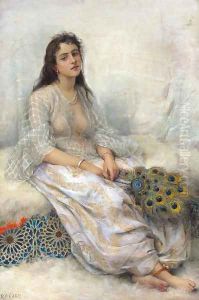Katherine-Augusta Carl Paintings
Katharine Carl was an American painter, writer, and court painter, born in 1865 in Siam (modern-day Thailand) where her father was a missionary, although she was raised in the United States. She pursued her art education in the United States and Europe, which was quite an achievement for a woman of her time. Carl's early career began with her work as a portrait artist, a field in which she gained significant recognition. Her talent and unique perspective as a female artist in a male-dominated field allowed her to carve out a niche for herself in the art world of the late 19th and early 20th centuries.
Carl's life took a dramatic turn when she was invited to China in 1903 to serve as a court painter to Empress Dowager Cixi. This opportunity arose from her growing reputation as a skilled portraitist and her connection with Sarah Pike Conger, the wife of the American Minister to China. During her time at the Chinese court, Carl painted what would become one of her most famous works, a portrait of Empress Dowager Cixi. This painting was exhibited at the St. Louis World's Fair in 1904 and garnered international attention. Her experiences at the Chinese court were later chronicled in her book 'With the Empress Dowager of China', providing a rare glimpse into the inner workings of the Qing Dynasty's royal court from a Western perspective.
After her return to the United States, Katharine Carl continued her work as a portrait artist but also became known for her writings and lectures on Chinese culture and her experiences at the court. Her contributions to cultural exchange between the East and West during a time of significant political and social change were notable. Throughout her career, Carl navigated the challenges of being a woman in a male-dominated profession, and her legacy includes not only her artistic works but also her role in bridging cultural divides.
Katharine Carl passed away in 1938, leaving behind a body of work that reflects her unique position as an American woman artist in the early 20th century. Her portraits, particularly of prominent figures, and her writings remain significant for their historical value and insight into the cultural intersections of East and West. Carl's life and work continue to be studied by art historians and scholars interested in the dynamics of cultural exchange and the role of women in the arts.
